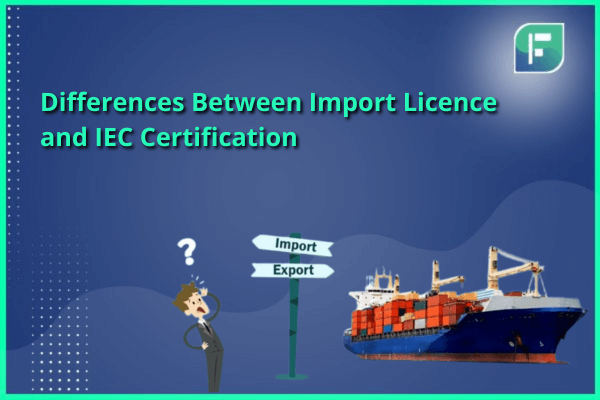The Import Licence and Import Export Code or IEC registration serve distinct purposes and there are significant differences between import licence and IEC certification. IEC, commonly known as the fundamental form of registration required for engaging in foreign trade, is essential for both importers and exporters before initiating their business activities. It signifies that involvement in import and export transactions is not permissible without obtaining an Import Export Code. In this blog, we will now understand the differences between import licence and IEC certification.
Is an Import Licence Still Necessary?
Despite the implementation of IEC registration, the concept of an import licence has not been entirely phased out. The import licence still holds relevance, albeit on a limited basis. As per the guidelines set by the Directorate General of Foreign Trade, individuals are required to obtain an import licence/authorisation in specific situations:
1. When importing restricted items listed under the ITS for commercial purposes.
2. When importing commodities from the United States for commercial purposes.
In both scenarios, securing import authorisation from the relevant authority is mandatory. To fulfil these requirements, applicants must submit a separate application. It is important to note that non-IEC holders are ineligible to fill out these forms, emphasising the continued necessity of obtaining an IEC registration.
Differences Between Import Licence and IEC Certification
The table below presents the key differences between import licence and IEC certification:
| Criteria | Import Licence/Authorisation | Import Export Code |
| Requirement | Required in special cases | Basic licence for importers and exporters in India |
| Form/Application | Fill ANF-2M form available on DGFT portal (manual) | Fill online application form |
| Applicability | Applicable for specific scenarios | Applicable in all export and import activities |
| Specific Cases for Application | 1. Import of restricted items under ITS (HS) | N/A |
| 2. Import of goods from the United States | ||
| Submission Method | Typically filled and submitted manually (ANF-2M form) | Entirely online for convenience |
Understanding Import Export Code and Its Relevance
The Import Export Code is a registration issued by the government, characterised by a distinctive 10-digit alphanumeric code. This code is allocated by the Directorate General of Foreign Trade once an online application is successfully submitted, and the necessary fees are paid. Possession of the IEC provides the holder with exclusive authorisation to export goods beyond the borders, in accordance with the EXIM policies outlined by the DGFT.
Key Features of Import Export Code
Some main features of IEC code are:
1. Alphanumeric Identification: The IEC consists of a 10-digit alphanumeric code.
2. Mandatory for Ethical Trading: It is mandatory for entities and individuals engaging in ethical import and export activities.
3. PAN-based Issuance: The IEC is issued against the Permanent Account Number (PAN) of the individual or the company.
4. Single Code per PAN: Only one IEC code can be obtained against a single PAN number.
5. Online Submission Process: The procedure for acquiring the IEC is entirely web-based, and individuals can modify the application on the internet before finalising the submission.
6. Digital Signature or Aadhaar One-Time Password: The submission of a new IEC application requires a Digital Signature or Aadhaar OTP as mandated by the DGFT.
7. DGFT’s Authority: The authority to issue the Import Export Code rests with the DGFT, or Director General of Foreign Trade.
8. Continuous Validity: The IEC maintains perpetual validity without the need for renewal.
9. Facilitating Transactions: Beyond simplifying the legal shipping process, the IEC facilitates the prompt processing of transactions held up in the importer’s bank.
10. Integration in Shipping Documents: The IEC is embedded in shipping documents like bills of lading, certificates of origin, and packing lists.
11. Customs Requirement: Customs require the IEC for clearing shipments from ports.
In contrast to an import licence, the Import Export Code is not subject to renewal and serves as a lifelong authorisation for engaging in import and export activities.
Principles of Restrictions for Import Licence and IEC Holders under the EXIM Policy
After seeing the differences between Import Licence and IEC Certification, let us see the restrictions on them. Both import licence and Import Export Code holders may face limitations on the trading of goods enlisted in the EXIM Policy. These restrictions are implemented to advance the following objectives:
1. Safeguarding the Well-being of the Public: The boundary are established to ensure betterment of the general population.
2. Guaranteeing the Well-being of Individuals: Measures are their to assure the well-being of individuals, plants, and animals associated with the exchanged commodities.
3. Upholding Rights to Intellectual Property: Measures are their to support and defend rights related to intellectual property.
4. Protecting National Archaeological Significance: The measures contribute to protecting the historical significance of national treasures.
5. Preserving National Resources: To maintain the preservation of national resources, specific restrictions are imposed on the trade of certain commodities.
6. Regulating Movement of Arms and Illicit Substances: Measures are enforced to control the unauthorized movement of arms and substances, enhancing national security.
Final Thoughts
The differences between Import Licence and IEC certification lies in their respective scopes and purposes. One of the major differences between Import Licence and IEC certification is that while the Import Licence, though still applicable on limited grounds, is sought for specific scenarios such as importing restricted items or commodities from certain regions, the IEC serves as a broader, government-issued registration facilitating ethical import and export activities. The IEC, represented by a 10-digit alphanumeric code, is mandatory for all entities and individuals engaged in international trade. Another major point of differences between Import Licence and IEC Certification is that unlike the Import Licence, the IEC is a lifelong authorisation issued against the Permanent Account Number and encompasses a comprehensive online application process, contributing to the efficiency and transparency of global commerce.






